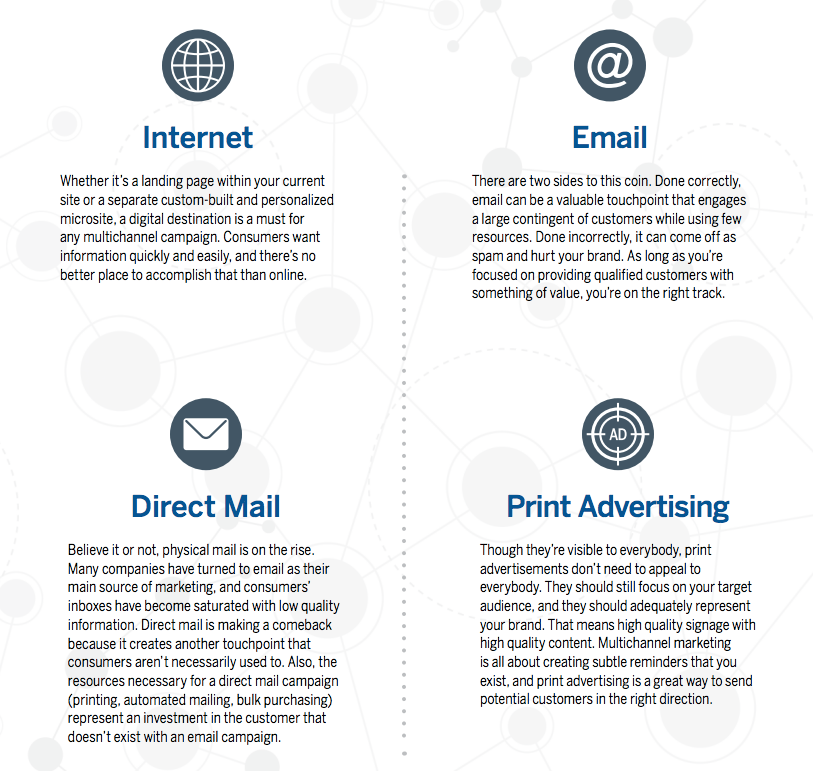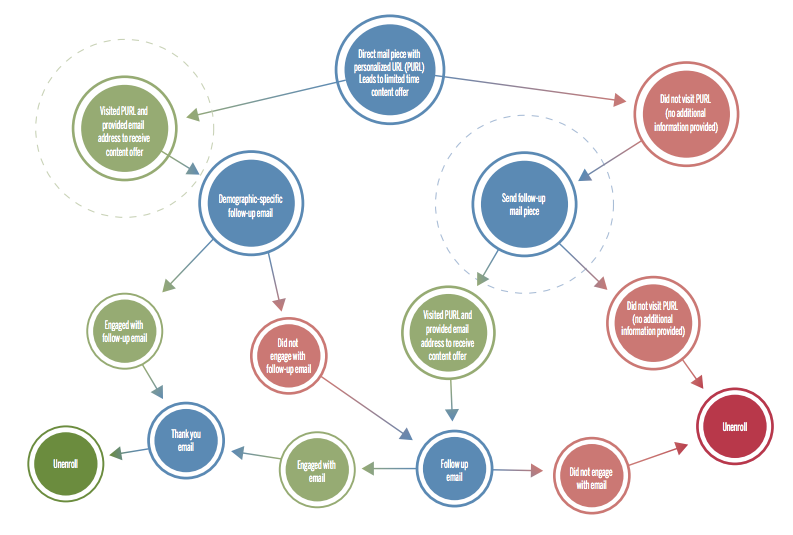
10 Key Steps for Creating a Successful Multichannel Campaign
Thursday , 07 September 2017 | resources
Today’s consumer is picky. Between flashy banner ads, spam emails, and colorful billboards, they’ve become numb to traditional marketing efforts. This oversaturation of advertising has spawned a new school of thought in the marketing world. Sometimes called “content marketing” or “inbound marketing,” it focuses on providing value to only the most qualified and relevant consumers (and leaving everybody else alone). Multichannel marketing works off this same concept. Through a variety of different channels, this approach aims to deliver valuable content to the people who want to see it.
When done well, a multichannel campaign is carefully researched and orchestrated to bring the company's message to the right people via a number of different mediums. Here are the ten key steps for creating a successful multichannel campaign.
1. Determine Your Specific Marketing Goal
Using a variety of marketing channels doesn't mean that you should attempt to meet a different marketing goal for every method of communication. Instead, determine a specific marketing goal and focus your energy toward it. What do you want to accomplish with your campaign? Are you looking to improve customer engagement? Increase sales?
Set a SMART goal, or a goal that meets the following criteria:
- Specific
- Measurable
- Achievable
- Relevant
- Time-based
This will help you ensure that you've created an actionable goal rather than a nebulous idea.
2. Determine and Put Focus On Your Intended Audience
Now, it's time to figure out who you want your campaign to address. If you're too general, it's possible that you won't reach your audience. You might gloss over their particular pain point or place emphasis on a feature of your product that doesn't interest them.
Instead, figure out who you're directing your campaign toward before you start. Then, you can focus every element planned on your intended audience, choosing the platforms that will be most compelling to your audience. Regardless of the platform, keep your messaging consistent. This aspect of personalization will make an impact on your audience and result in increased engagement with your campaign overall.
3. Create a Compelling Offer with a Creative Message
Regardless of the platform, it's important that you create a compelling offer to capture the interest of your audience. What are the components of a compelling offer?
- Benefit— How will it improve your customer's current situation?
- Differentiator— What sets you apart from your competitors? What makes your offer better than the rest?
- Call-To-Action— What do they need to do to get what you're offering?
The beauty of a multichannel campaign is the fact that you can combine both print and digital methods to create unique and creative messaging through a variety of platforms.
4. PURLs, CTAs, Direct Mail, and General Good Design
It's time to focus on building better lists. To nurture a list of receptive prospects, you're going to need to put forth a little effort. How? Here are a few simple ways to build a better list.
Personalized URL (or PURL)— A PURL is a special landing page that was created specifically for the recipients of a direct mail or email campaign. Why is this a good tool for building a better list? It will not only improve the response rates—when a person is given a URL with their name in it, they're more likely to make the effort to click on it— but it will also improve your response tracking. You'll know immediately who's responded, and you can trigger a previously established automated workflow to start targeting them directly.
Calls-To-Action (CTAs)— Any good piece of marketing, whether it's print or digital, will contain a call-to-action, or CTA. Why? Well, without one, your customer won't know how or where to get what you're offering. Give them the guidance they need to take advantage of your product, and you'll be pleasantly surprised by the results.
Direct Mail— A direct mail campaign simply targets the people who are most likely to be interested in an offer, rather than blitzing everyone in town with your marketing materials. For example, if you owned a pizza parlor, it would be smart to orchestrate a direct mail campaign for the college campus in your town. (Pizza and late night studying are old friends.) Whether you choose to use a postcard, standard letter, or self mailer depends upon the message you're seeking to convey. Work with your printing partner to decide which is best for you.
Good Design— No matter what format you choose, be sure that you've created something that's attractive and well-designed. Whether it's a piece of direct mail, a point of purchase sign, or a landing page, it must be eye-catching and carefully laid out.

5. Determine Your Automated Response Paths and Tracking Needs
In order to map out the path your buyers will take, you need to have a big picture view of the twists and turns of the buyer's journey. You'll also need the tools, systems and processes to automate and track your campaigns. This includes marketing automation software, email marketing, Google Analytics and/or other analytics systems, website pages and landing pages, CRM or contacts database, and much more.

6. Test for Success
You're ready to go live with your campaign, but hold off—first, you need to test to make sure it will all go off without a (potentially costly) hitch. Review the materials that you need to have printed very carefully to ensure that they look exactly the way you want, send out an email to a select group to gauge their response, and ensure that your prospect lists are clean, without duplicates.
7. Execute, React, and Respond
The time has come! It's time to launch the multichannel campaign at last! Now, follow the steps you've set out to release your campaign across a variety of channels at once. As the results start to roll in, it's up to you to react and respond to your prospects' responses.
8. Follow Through
Now, you need to decide how to follow up this campaign. Do you continue down the same path, further exploring your original goal? Do you want to set a new goal? Reach a different audience? The sky's the limit.
9. Measure Results
Here's where you discover if you've planned your campaign well. Conduct analytics to see if you're getting the response you hoped to achieve. For example, if you chose to utilize PURLs, you can easily analyze how successful you were. If you sent out 100 PURLs, and you had 45 people click on them, you know that you had a 45% success rate. Check your response on every channel you used, so you can see what you must do to improve on each medium.
Marketing generates a lot of data, so you need to have a predetermined method for tracking your conversion metrics. If you're using digital methods, it's a little easier to track than offline marketing, but that doesn't mean that tracking your offline marketing efforts isn't just as valuable. However, you should probably keep your metrics focused on the most basic level in order to maintain clarity.
10. Determine How to Improve Current Processes
Now that you've collected your data, you've got the information you need to make your multichannel campaign even better in the future. Is one platform outperforming the rest? Is one significantly underperforming? Now you know where to focus your attentions when you conduct the next campaign.
There’s no “one size fits all” approach to a successful multichannel campaign. If it were that easy, everybody would be doing it! For as many challenges as they present, multichannel campaigns offer exponentially more chances for success. The key is utilizing your industry knowledge in a way that the
competition is not. Ready to move ahead with multichannel marketing? Download our free getting started guide here.
Sep 07, 2017 |
Topics: resources


